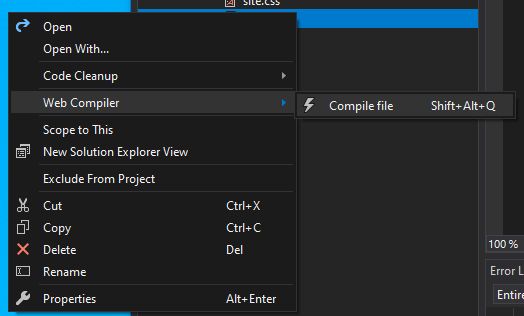
#Prepros sass compiler install
I recommend this way, as it is the simplest and easiest way to install and configure Sass.
#Prepros sass compiler how to
Now installation and configuration are complete! You can use Sass in your projects.īut before we get into how to use Sass, I want to show you a second way of doing it. Style.scss is the source file and style.css is the destination file where Sass generates the CSS code. Then you will use the following command to generate a style.css file from the SASS file: sass -watch style.scss style.css Then, in the project folder, create a Sass file un the one you are going to work on: style.css If you do this, you avoid installing it every time you plan to work with Sass in your projects.

Here are the steps to follow to install and set up Sass in a project:įirst, open your terminal and type: npm install -g scssĪgain, this is global installation. We are going to do a global installation, because this will save you from installing it every time you plan to work in your projects with Sass. Then we'll use the JavaScript package manager npm to install Sass and configure it in your project. How to Install Sass with Node.jsįirst, we'll download and install Node. In this article, I'll show you two ways to install Sass. This is thanks to its features like functions, variables, inheritance, and so on.įinally, Sass is compiled to CSS and adds all the necessary vendor prefixes so you don't have to worry about writing them manually. Speaking of saving time, Sass reduces the repetition of writing CSS code.
#Prepros sass compiler code
This helps you save time and allows you to code faster. Sass also makes it possible to reuse your code by creating variables and functions with mixins (cutting up pieces of code) that can be reused over and over again. Since it's a CSS preprocessor its syntax is similar.Īlso, if you use Sass, your CSS code will be compatible with all versions of browsers. There are many advantages to using Sass, so let's look at some of them now:įirst, Sass is easy to understand if you know CSS.

scss file, it is compiled into a regular CSS file that the browser will use to display it on the web page.

This transformation is called compilation. To do this, the compiler will generate a file with the CSS code. This means that you have to transform the Sass code into CSS code. The web browser does not understand Sass code, though – it only understands CSS code. Sass lets you reuse your code, split it into files, and it also helps you create functions, variables, nest your CSS selectors, and other shortcuts. These features will help you write maintainable CSS code. This is where Sass becomes useful, as it has features that don't yet exist in CSS like nesting, creating functions with mixins, inheritance, and more. Sass is a CSS preprocessor that helps you manage tasks in large projects where the style sheets get larger, you have a number of lines of CSS code, and it becomes difficult to maintain your CSS codes. Hi there! If you are reading this article, you're probably trying to understand what Sass is and how it works.


 0 kommentar(er)
0 kommentar(er)
